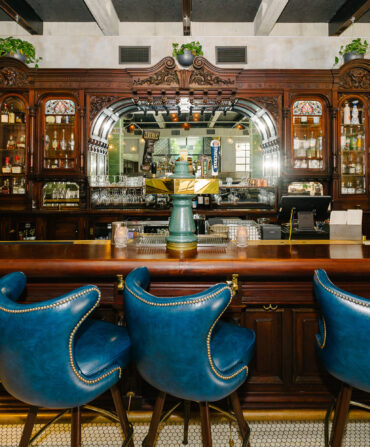The High Horse opened in Louisville, Kentucky’s Butchertown neighborhood last year, taking over a space that has been home to a bar since the 1930s. As Lee’s Tavern, it was the site of what the local newspaper referred to as a “battle royal” in 1950, when seventy-five Fort Knox soldiers got to brawling, leading a judge to deem it “the roughest and toughest place in town.” It later became the Do Drop Inn, noted for its large dance floor. A sign out front reading NICE PEOPLE DANCING TO GOOD COUNTRY MUSIC became a longtime neighborhood landmark.
The High Horse’s slogan—ROUGHEST & TOUGHEST PLACE IN TOWN—came from that judge’s 1950 decree. The bar has the retro vibe of your great-uncle’s rumpus room, circa 1982, complete with faux fireplace and pinball machines. (Your cool great-uncle, not the other one.) When it comes to its drinks, though, High Horse takes a sharp turn from its scrappy past. Coproprietor Marie Zahn calls them “disco drinks,” which is to say cocktails popular when the Bee Gees were still played without irony. Think: cheap White Russians and two-dollar PBRs. But then, think again. Because Zahn and crew have blended the precepts of modern mixology with a tumbler of “don’t really care what you think.” So they also serve up a Redneck Russian made with Yoo-hoo. And a Singapore Sling in which the traditional cherry brandy is replaced with cherry White Claw. Don’t judge; they’re quite good.
And that brings us to the Harvey Wallbanger, a drink likely spilled on more shag carpets than any other. Its popularity in the 1960s and ’70s in large part resulted from the savvy marketing behind Galliano, an Italian liqueur with vanilla and anise notes. Among the brand’s ploys: a nutty campaign during the 1972 presidential election (Nixon v. McGovern), in which ads encouraged write-in votes for “Harvey Wallbanger.” The drink reportedly received several thousand votes.
Initially, Zahn wanted to put a cocktail featuring orange juice on the menu—the bar goes through a lot of orange peels for garnishes, and she didn’t want to waste the fruit. High Horse has been known to serve up at least three versions of the Harvey Wallbanger—the classic (vodka, Galliano, orange juice), along with the Bang A Rang, which involves Tang syrup and sherry. The third—a punch-sized Julius Wallbanger—is named with a nod to what Zahn calls the “creamy Orangesicle flavors” of the shopping mall drink of yore. It’s a variation on a clarified milk punch, made via a two-step process that uses the citrus juice to curdle milk, after which the solids are strained out, leaving a more-or-less limpid liquid. “It has a silky mouthfeel like with cream,” Zahn says.
No word on whether Julius is gearing up for a late entry in the upcoming November election.
This article appears in the June/July 2020 issue of Garden & Gun. Start your subscription here or give a gift subscription here.








